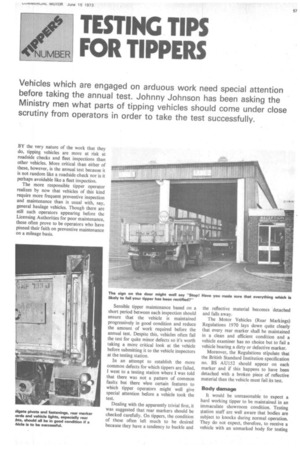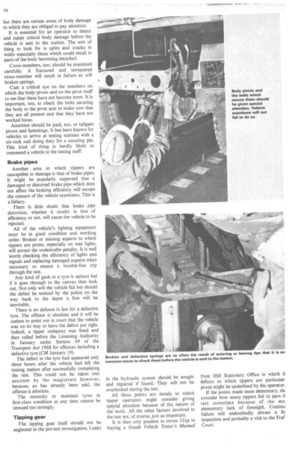TESTING TIPS FOR TIPPERS
Page 59

Page 60

If you've noticed an error in this article please click here to report it so we can fix it.
Vehicles which are engaged on arduous work need special attention before taking the annual test. Johnny Johnson has been asking the Ministry men what parts of tipping vehicles should come under close scrutiny from operators in order to take the test successfully.
BY the very nature of the work that they do, tipping vehicles are more at risk at roadside checks and fleet inspections than other vehicles. More critical than either of these, however, is the annual test because it is not random like a roadside check nor is it perhaps avoidable like a fleet inspection.
The more responsible tipper operator realizes by now that vehicles of this kind require more frequent preventive inspection and maintenance than is usual with, say, general haulage vehicles. Though there are still such operators appearing before the Licensing Authorities for poor maintenance, these often prove to be operators who have pinned their faith on preventive maintenance on a mileage basis. Sensible tipper maintenance based on a short period between each inspection should ensure that the vehicle is maintained progressively in good condition and reduce the amount of work required before the annual test. Despite this, vehicles often fail the test for quite minor defects so it's worth taking a more critical look at the vehicle before submitting it to the vehicle inspectors at the testing station.
In an attempt to establish the more common defects for which tippers are failed, I went to a testing station where I was told that there was not a pattern of common faults but there vere certain features to which tipper operators might well give special attention before a vehicle took the test.
Dealing with the apparently trivial first, it was suggested that rear markers should be checked carefully. On tippers, the condition of these often left much to be desired because they have a tendency to buckle and the reflective material becomes detached and falls away.
The Motor Vehicles (Rear Markings) Regulations 1970 lays down quite clearly that every rear marker shall be maintained in a clean and efficient condition and a vehicle examiner has no choice but to fail a vehicle bearing a dirty or defective marker.
Moreover, the Regulations stipulate that the British Standard Institution specification no. BS AU152 should appear on each marker and if this happens to have been detached with a broken piece of reflective material then the vehicle must fail its test.
Body damage It would be unreasonable to expect a hard working tipper to be maintained in an immaculate showroom condition. Testing station staff are well aware that bodies are subject to knocks during normal operation. They do not expect, therefore, to receive a vehicle with an unmarked body for testing
but there are certain areas of body damage to which they are obliged to pay attention. It is essential for an operator to detect and repair critical body damage before the vehicle is sent to the station. The sort of thing to look for is splits and cracks in welds especially those which could result in parts of the body becoming detached. Cross-members, too, should he examined carefully. A fractured and unrepaired cross-member will result in failure as will broken springs. Cast a critical eye on the members on which the body pivots and on the pivot itself to see that these have not become worn. It is important, too, to check the bolts securing the body to the pivot arm to make sure that they are all present and that they have not worked loose.
Attention should be paid, too, to tailgate pivots and fastenings. It has been known for vehicles to arrive at testing stations with a six-inch nail doing duty for a securing pin. This kind of thing is hardly likely to commend a vehicle to the testing staff.
Brake pipes
Another area in which tippers are susceptible to damage is that of brake pipes. It might be popularly supposed that a damaged or distorted brake pipe which does not affect the braking efficiency will escape the censure of the vehicle examiners. This is a fallacy. There is little doubt that brake pipe distortion, whether it results in loss of efficiency or not, will cause the vehicle to be rejected. All of the vehicle's lighting equipment must be in good condition and working order_ Broken or missing aspects to which tippers are prone, especially on rear lights, will attract the undesirable penalty. It is well worth checking the efficiency of lights and signals and replacing damaged aspects when necessary to ensure a trouble-free trip through the test. Any kind of gash in a tyre is serious but if it goes through to the canvas then look out. Not only will the vehicle fail but should the defect be noticed by the police on the way back to the depot a fine will be inevitable.
There is no defence in law for a defective tyre. The offence is absolute and it will be useless to point out in court that the vehicle was on its way to have the defect put right. Indeed, a tipper company was fined and then called before the Licensing Authority in January under Section 69 of the Transport Act 1968 for offences including a defective tyre (CM January 19). The defect in the tyre had appeared only three hours after the vehicle had left the testing station after successfully completing the test. This could not be taken into account by the magistrate however, because, as has already been said, the offence is absolute. The necessity to maintain tyres in first-class condition at any time cannot be stressed too strongly.
Tipping gear
The tipping gear itself should not be neglected in the pre-test investigation. Leaks in the hydraulic system should be sought and repaired if found. They will not be overlooked during the test. All these points are details to which tipper operators might consider giving special attention because of the nature of the work. All the other factors involved in the test are, of course, just as important. It is then only prudent to invest 324p in buying a Goods Vehicle Tester's Manual from HM Stationery Office in which tl defects to which tippers" are particular prone might be underlined by the operator. If the points made seem elementary, tin consider how many tippers fail to pass tl test sometime because of the mo elementary lack of foresight. Continu failure will undoubtedly attract a flt inspection and probably a visit to the Traf Court












































































































































